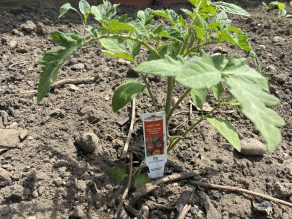Un-chard-ed Territory: Growing Vegetables at Home
Environment | June 7, 2022
With the rise in food prices and a stronger focus on healthier eating, many people are looking into growing and harvesting their own vegetables. Growing your own produce is a simple and inexpensive form of urban agriculture.
There are many benefits to growing a vegetable garden. It’s an easy way to save money, stay active and make healthier food choices. It also allows you to control the growing environment in your garden, avoiding the use of pesticides and other chemicals and ensures you have access to nutritious and healthy food. Growing your own food helps to mitigate the effects of climate change by reducing food miles (the distance food travels from farm to plate) and greenhouse gas emissions and is a great teaching tool and activity to do with your kids.
Where to start
Picking the right location is an important step. Most vegetables need about six to eight hours of sunlight per day and should be in a place that’s not too windy. Look for a spot that has proper drainage so that plants and soil don’t get overly saturated with water or water doesn’t pool in different areas, causing your plants to rot.
It’s also important to feed your plants the right nutrients. This will help you get a better crop yield. To provide valuable nutrients, you can add organic matter to your soil, such as compost made from grass clippings, dry leaves and garden scrapes.
Most vegetables need to be planted every year unless they are perennial crops like asparagus, rhubarb and some herbs. Not all vegetables can be planted at the same time. There are two seasons for vegetables – cool and warm:
- Cool-season vegetables include peas, lettuce and carrots. The soil needs to be around 10o C to start planting these vegetables.
- Warm-season vegetables include tomatoes and peppers. The soil needs to be as warm as possible for optimal planting. Consider planting these crops at the end of May or early June.
Keep in mind that some crops mature quickly and have a short harvest period (e.g., lettuce), while others (e.g., tomatoes) take longer to produce. By staggering plantings at different times, you can have crops to harvest all season long.
What to plant
If you’re new to planting vegetables, here are a few worry-free choices to consider when planning your garden.
Lettuce – Lettuce is a leafy green that grows well in the spring and fall. Lettuce grows quickly, so plant a small amount of seeds at a time. Remember to water your lettuce plants frequently.
Tomatoes – Tomatoes come in many different varieties. They love direct sunlight and are perfect to plant in the spring and early summer. Tomatoes can produce a hefty yield.
Bell Peppers – Peppers are a warm-season crop that come in a variety of colours, shapes, sizes and degree of heat. Peppers have a long growing season of between 60 to 90 days. Peppers love sunlight and enjoy moist soil. They are best planted in late spring.
Carrots – Carrots are a cool-season crop grown in spring. They prefer the sun from six to 10 hours per day. The soil should be free-draining and should be sandier for the best yield.
Spinach – Spinach is a leafy green and is a popular crop that can be planted in very early spring, as well as in fall. Spinach has cool-season growing conditions and requirements similar to lettuce. Spinach tolerates full sun to light shade.
Don’t have a large outdoor space or feel overwhelmed? You can start with a small garden or try growing crops in pots on balconies, a front porch or even indoors. Leafy greens, herbs and tomatoes are all great small-space gardening options and grow well in a small raised garden bed or pot. Indoor gardening is also an option if an outdoor space is not available or you want to grow year-round. Just keep in mind the same sunlight, water, drainage and nutrient requirements for large outdoor gardens still apply when growing indoors.
Now that you have enough information to get started, it’s time to dust off your trowel, get your hands dirty, start planting and then share your harvest and experience with friends and neighbours.
Learn more about what the City and the community are doing to support urban agriculture in Mississauga at mississauga.ca/homegrown.
For growing tips and detailed advice for starting an urban food garden, read the Grown in Mississauga Training Manual developed by Ecosource.
Tags
Media contact
City of Mississauga Media Relations
media@mississauga.ca
905-615-3200, ext. 5232
TTY: 905-896-5151



